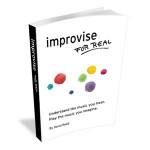 Today I’m providing an Improvise for Real review to more fully explain the incredible value music students can get by taking a new approach to learning improvisation.
Today I’m providing an Improvise for Real review to more fully explain the incredible value music students can get by taking a new approach to learning improvisation.
This is a new method and is an online product offering by David Reed. David has written a couple of fantastic articles about improvising myths for the Music Learning Blog.
David and I have different opinions and approaches to learning music, but this is good because different people have different ways as well as timing of learning.
This extensive method of exercises is well worth your consideration. Actually he calls them exercises, but I’m going to say they’re more an exploration into harmony through discussion and implementation.
Below I take a look at the structure of this book.
******UPDATE******
New for 2018
David has expanded his offerings supporting Improvise for Real You can check out the entire course materials here:
IFR Jam Tracks Level 1: Seven Worlds
IFR Jam Tracks Volume 2: Pure Harmony Essentials
New Workout volume with five Jazz standards:
IFR Standards Workout 1
and introducing the stand alone full and complete
Basics Structure of Improvise for Real
This method is provided in a PDF eBook, and has 253 pages from cover to end. There are plenty of illustrations and this isn’t big print font either. There is a ton of valuable reading and study material in those pages.
Improvise for Real is broken down into 44 chapters and with over 35 of them directly related to getting you into the improvisation study. The specific exercises, which we’ll cover shortly, are covered in one chapter each; but usually broken into segments or sub parts. The additional chapters in each exercise reinforce and expand the primary exercise.
The introduction chapters cover the philosophy of the method and approach. The final chapter is about David and how this whole project came about.
In addition to the eBook you can also get a set of jam tracks to use with the exercises and allow you to improvise solos as you start your study of exercise 2. There are 35 tracks and a 37 page guide on using the tracks. These tracks can be used without the course book to do your own thing, but were designed to be used with the Improvise for Real method.
The 5 Areas of a Musical Abstraction
The Improvise for Real method uses what are called 5 exercises, and David admits these are more like 5 levels of abstractions and are complete study areas in themselves. He states about these five areas study:
..together they form a complete method for lifelong musical growth.
Now that’s heartening to hear, but may also put you off. Don’t think about learning one musical idea and mastering it in an instant; that doesn’t work. You should be looking for principles that allow you to grow continually. This is what I’m getting out of this discourse.
As such these 5 exercises are a larger framework for your continued development. Some may find the full enjoyment in just the first two exercises, others will strive for mastery in the other exercises.
Let’s take a quick review of the 5 parts and discuss the topics covered.
Exercise 1, Landscape – Visualize Your Entire Musical Range
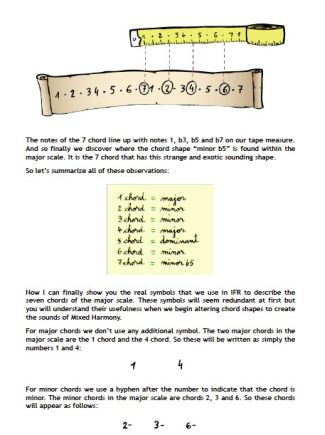 The first objective of the Improvise for Real method is to continually improve your ability to clearly visualize your entire musical range.
The first objective of the Improvise for Real method is to continually improve your ability to clearly visualize your entire musical range.
This is a discover exercise and it’s not hard, but you’ll want to rush past it. DON’T! As I think about the approach being taken here it’s about mental visualization while doing the physical work.
You’ll be studying musical scales, but this approach is so very different than how we learn them in the traditional manner.
I like my mathematical formula approach and when I look at David’s approach I realize I got there with the logical approach, but this exercise method really engages the brain in a new aspect.
Also there’s a supplemental section for the guitar as well as the electric and upright bass in getting started with this exercise.
After your initial foray into Landscape you’ll be taken on a path to give you a proper mindset for both your understanding of the approach as well as focusing your attention to listening. You’ll find a unique approach to visualizing and learning notes and the basic scale pattern you’ll be utilizing for improvisation.
For those of you that have studied music with our system or others you may find these areas a bit simple or even trivial. But don’t mistake your knowledge for the ability to look at this information from a new angle. It is giving me a new appreciation for approaching music and exciting my thought process for more experimentation.
Exercise 2, Melody – Relating Sounds To the Major Scale And To Your Instrument
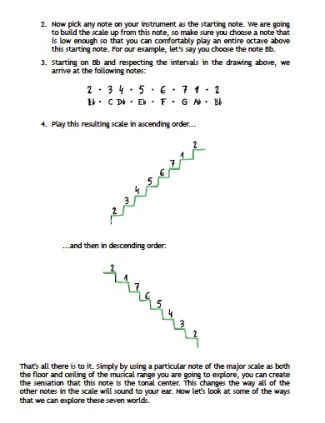 This is really the nuts and bolts of Improvise for Real. Here you are going to learn to create by using the basic foundation of music.
This is really the nuts and bolts of Improvise for Real. Here you are going to learn to create by using the basic foundation of music.
In classical training we use the scales as practice and are very pragmatic in our continued practice to be smooth and structured in playing these scales. With the improviser the scale practice is not as rigid. In fact it’s taking this structure and having many different experiences with these set of notes.
I’d like to quote David again because I thought he put it so well:
…show you a wide variety of musical activities that will help you enter the beautiful world of harmony and discover its lessons for yourself.
This hit home for me, because my effort in the past few years has been just about this type of exploration and discovery. Gee David, where were you when I needed you then? But, I digress…
David uses some simple but powerful visual aids to approach this exercise. It gave me a new representation on viewing the rising and descending scale approach.
After getting you all set up with tonal numbering, the next part goes into singing freely. All of my teachers were about doing this aspect of music, but of course I was too insecure to go down that road, I do it more now and sure wish I’d started doing it much earlier in my study days.
Exercise two continues with moving these into advanced implementation. After that there are another series of thought provoking mini articles to help your mind expand on using the concepts of exercise 2. Working these ideas can easily provide you with hours of enlightenment and entertainment.
This one study area is worth many times the cost of this eBook for the value you will get out of it alone.
Exercise 3, Pure Harmony – The Seven Harmonic Environments to Create Your Own Music
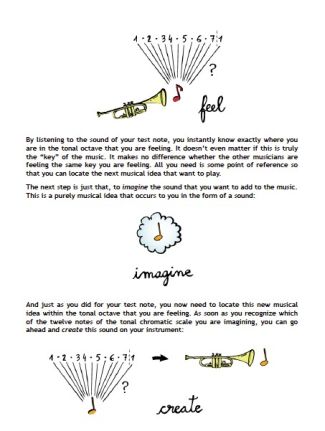 This part of the Improvise for Real method is a continuation and expansion of improvising in the modes of the major scale started in exercise 2 which limited to working within one octave. The exercises within this exploration will take you into an expanded range of tonal reach.
This part of the Improvise for Real method is a continuation and expansion of improvising in the modes of the major scale started in exercise 2 which limited to working within one octave. The exercises within this exploration will take you into an expanded range of tonal reach.
As with the previous section the simple visual tools and your mind process is going to make this a mesmerizing study experience.
There are 7 essential sections to apply improvisation practice in this exercise from expanding range, understanding home chords, accompanying, following harmony, and chord comping.
The follow up chapters again cover ways to expand your skills when improvising where you are engaged about time, composing your own music, jamming, understanding tensions and release as well as a looking at musical shapes and distances.
Once again this is a complete study that is many times more valuable than the book.
Exercise 4, Mixed Harmony – Create Temporary Deformation to the Basic Harmonic Environment
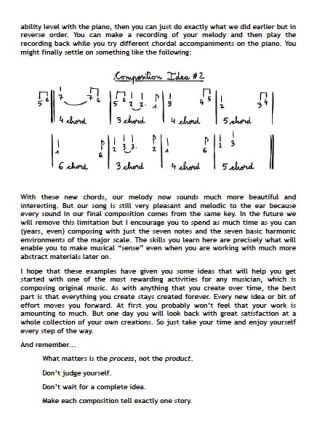 Instead of using theory to try to explain unusual chords David uses a method to allow you to explore these chords for yourself.
Instead of using theory to try to explain unusual chords David uses a method to allow you to explore these chords for yourself.
Now I’ve studied and found a way for me to use the logical approach that fits me well and I understand these concepts, but this section is just going to blow you away when you get here.
Don’t hurry to get here take the time to build to this point. As this builds on everything that comes before it, you’ll need to have built up the background to understand and explore the mixed harmony path.
The visual tonal maps are going to bring you along from where you’ve been and really start you into playing and improvising in jazz, blues, and free improvisation in the follow up chapters.
I’m not going to try and get into a detailed explanation of the process here, but understand this is the next step becoming hip in your improvisations.
Exercise 5, Free Harmony – Play Entirely From Your Own Imagination
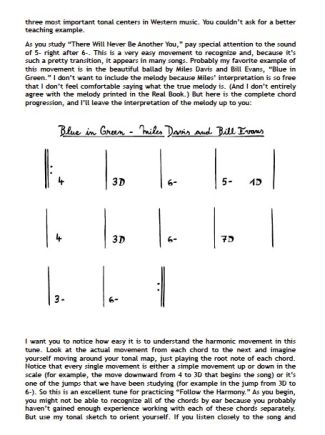 I’m sure this is where we all want to end up, and in many cases the great musicians were able to spend the time to get to this point or were mentored in a way that got them there fast. Many others have taken years to get there, so don’t worry about if you’re not there.
I’m sure this is where we all want to end up, and in many cases the great musicians were able to spend the time to get to this point or were mentored in a way that got them there fast. Many others have taken years to get there, so don’t worry about if you’re not there.
David is really taking aim at the standard music theory methods and why we don’t end up in the free harmony mode.
In one sense I’ve got to agree with him, in another I disagree. The structure of music theory is what brought music to me and has allowed me to move into the realm of improvisation. On the other hand I’m at the point of agreeing that we should not be to attached to the rules and we should get beyond right and wrong notes.
Many of us will listen to jazz and hear noise; I listen to the metal genre and do the same. It’s about getting rid of the bias and letting yourself explore the music with just sounds. Each person will have their own value of good and bad and I find today that sounds I hear and play would never have been palatable 20 years ago.
So I’m going to fully embrace the concepts of letting the ear drive the ambiguous movement of my music with the way I feel at the moment.
These sections of promoting your new found abilities will push any level of musician to explore their deepest desires of creativity.
Summarizing Improvise for Real
The approach is so different to what you’ll see in our regular course offering that I consider this method to be an essential element to add to your study of music.
Yes, it could be your total study of music and would serve you well. But am I willing to give up the music theory study? No, I think in many ways these two approaches are complimentary methods and have both valuable teaching opportunities to how people learn differently.
Value of Improvise for Real:
Improvise for Real is an absolutely incredible value! Compared to what I’ve seen offered this focused intent on improvisation is the best value around.
I think that this material can be added at any stage of your development.
Suggestions:
- Get this method; then plan on spending quality time working with the exercises on a weekly basis.
- Do not hurry through it. Take your time to explore each and every segment.
- Don’t expect you’re going to get through the exercises fast. This material is not about quickly learning something then getting on to the next thing. It’s about a life long journey of music exploration.
- Approach with an open mind. You don’t have to agree with everything that David is saying and I only say this because you may learn and absorb your information differently than what his experiences have been. However, everything he says has a truth behind it and it might or might not apply to you.
Action to take:
Get the Improvise for Real course today and start your improvising journey now. I can only think of where you will be in 3 months or a year from now.
Click on the image or link here to discover improvising:
![]()
IFR Jam Tracks Volume 1: Seven Worlds
IFR Jam Tracks Volume 2: Pure Harmony Essentials
New Workout volume with five Jazz standards:
and introducing the stand alone full and complete
